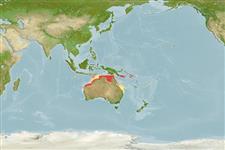Elasmobranchii (tubarões e raias) (sharks and rays) >
Carcharhiniformes (Ground sharks) >
Carcharhinidae (Requiem sharks)
Etymology: Carcharhinus: karcharos (Gr.), sharp or jagged; rhinus, an ancient name for sharks, from rhine (Gr.), rasp, both words alluding to a shark's jagged, rasp-like skin. (See ETYFish); tilstoni: In honor of Richard Tilston, naturalist-surgeon at Port Essignton, Northern Territory, near where holotype was collected in the 1840s. (See ETYFish).
More on author: Whitley.
Environment: milieu / climate zone / depth range / distribution range
Ecologia
marinhas; estuarina; intervalo de profundidade 0 - 150 m (Ref. 6871). Tropical; 10°S - 28°S
Indo-West Pacific: currently known only from the continental shelf of tropical Australia. Very similar to Carcharhinus limbatus and reliably distinguished only by biochemical studies and vertebral counts (Ref. 9819).
Comprimento de primeira maturação / Tamanho / Peso / Idade
Maturity: Lm ?, range 115 - ? cm
Max length : 200 cm TL macho/indeterminado; (Ref. 9997); peso máx. publicado: 52.0 kg (Ref. 6390); idade máx. registrada: 12 anos (Ref. 6390)
Espinhos dorsais (total): 0; Raios dorsais (total): 0; Espinhos anais 0; Raios anais : 0. Back dark grey, ashy blue or dusky bronze; belly white or yellowish white; a dark band extending rearward along each side to about over origin of pelvic fin; tips of pelvic fins with a persistent black spot (Ref. 9997).
Found on the continental shelf from close inshore to about 150 m depth (Ref. 9997). Found throughout the water column but usually near the sea bed during the day and near the surface at night (Ref. 6390). Prefers teleost fishes but also feeds on cephalopods to a lesser degree. Viviparous (Ref. 50449). Forms large aggregations (Ref. 6871). Utilized for its meat and fins (Ref. 6871). The flesh has a relatively high mercury content (Ref. 6871).
Viviparous, placental (Ref. 50449). The average litter size is 3, with a range of 1-6, average total length at birth is 60 cm. Pups are born in January after a 10-month gestation period. These sharks breed once each year (Ref. 13440). Distinct pairing with embrace (Ref. 205).
Kailola, P.J., M.J. Williams, P.C. Stewart, R.E. Reichelt, A. McNee and C. Grieve, 1993. Australian fisheries resources. Bureau of Resource Sciences, Canberra, Australia. 422 p. (Ref. 6390)
Status na Lista Vermelha da UICN (Ref. 130435)
Ameaça para os humanos
Harmless
Uso pelos humanos
Pescarias: pouco comercial
Mais informação
ReferênciasAquaculturaPerfil para aquaculturaEstirpesGenéticaElectrophoresesHereditariedadeDoençasProcessamentoNutrientsConversão de massa
ColaboradoresFotosStamps, Coins Misc.SonsCiguateraVelocidadeTipo de nataçãoÁrea branquialOtólitosCérebrosVisão
Ferramentas
Relatórios especiais
Baixar XML
Fontes da internet
Estimates based on models
Preferred temperature (Ref.
123201): 26 - 28.7, mean 27.7 °C (based on 424 cells).
Índice de diversidade filogenética (Ref.
82804): PD
50 = 0.5000 [Uniqueness, from 0.5 = low to 2.0 = high].
Bayesian length-weight: a=0.00479 (0.00221 - 0.01036), b=3.09 (2.92 - 3.26), in cm total length, based on LWR estimates for this Genus-body shape (Ref.
93245).
Nível Trófico (Ref.
69278): 4.2 ±0.6 se; based on diet studies.
Generation time: 7.8 ( na - na) years. Estimated as median ln(3)/K based on 2
growth studies.
Resiliência (Ref.
120179): Baixo, tempo mínimo de duplicação da população 4,5 - 14 anos (K=0.14; tm=3-4; tmax=12).
Fishing Vulnerability (Ref.
59153): High to very high vulnerability (70 of 100).
